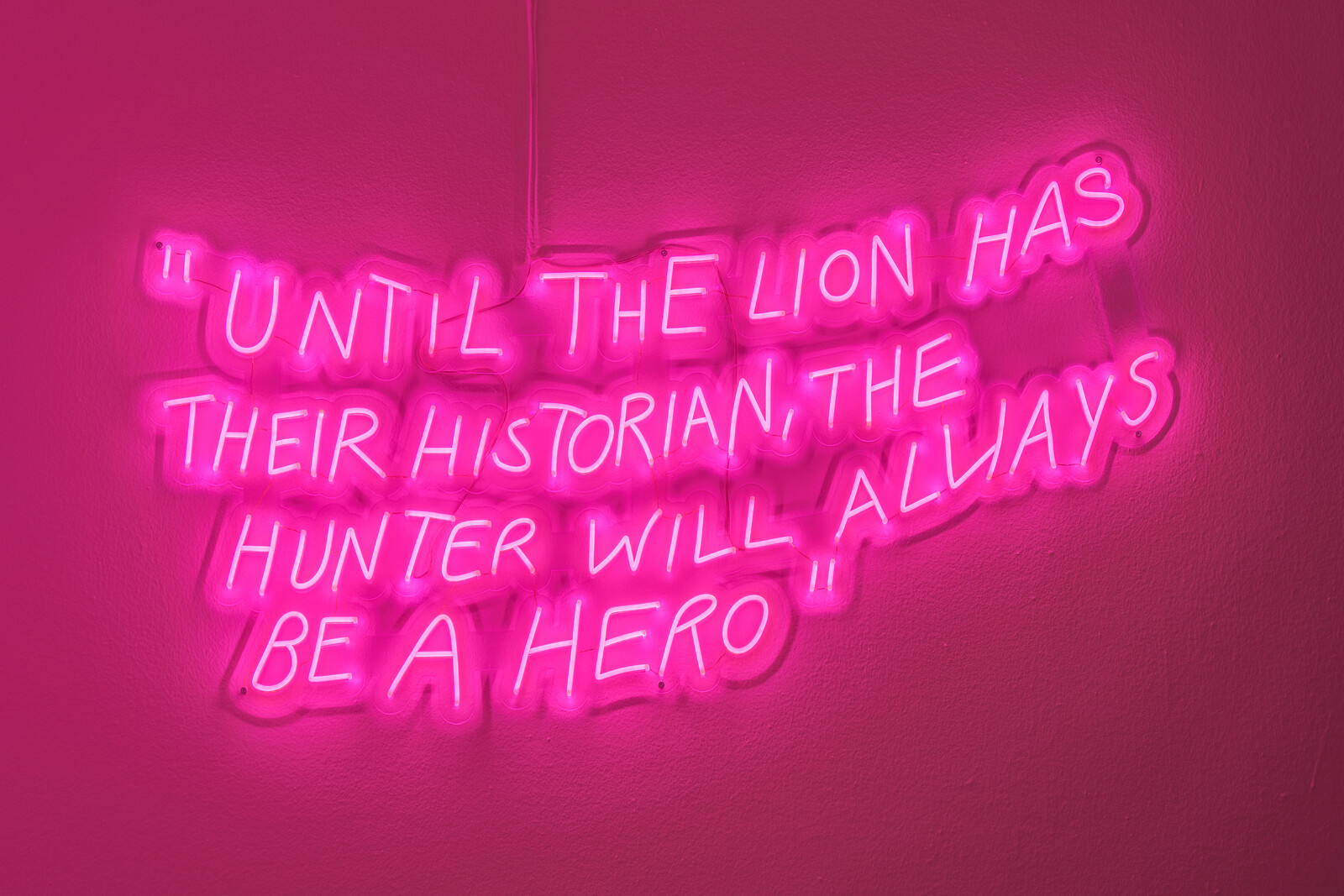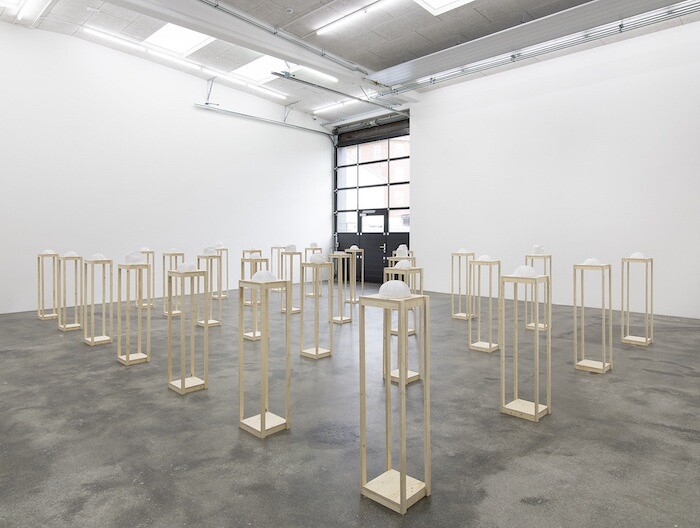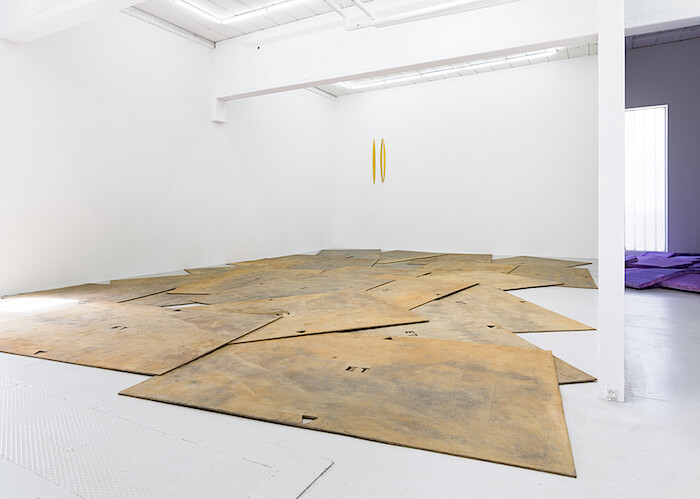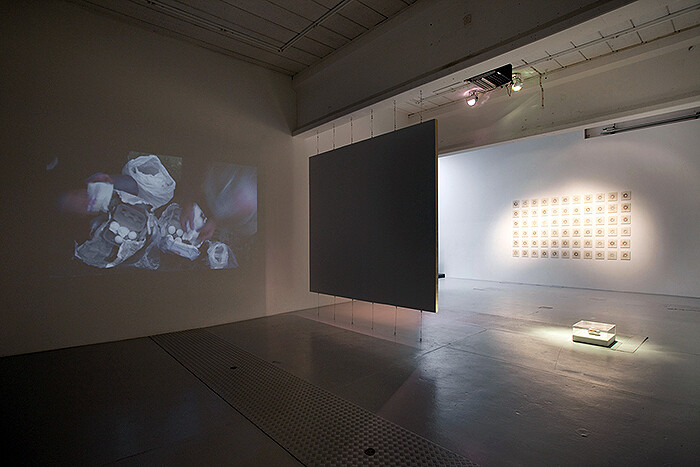Categories
Subjects
Authors
Artists
Venues
Locations
Calendar
Filter
Done
January 19, 2023 – Review
“AMOUNT”
Alice Godwin

The subterranean rooms of artist-run space Simian, in Copenhagen’s Ørestad district, could easily be mistaken for an underground bunker after the industrial apocalypse. Ørestad itself is a curious reminder of failed human design: an eerily deserted hangover from a bold urban plan to transform this area of wetlands on the edge of a nature reserve into a metropolitan center with gleaming glass buildings and a floating metro line. In the bowels of an old bicycle lockup, it feels as if the only souvenirs of the old industrial world are artworks by Toke Flyvholm, Yuri Pattison, Naïmé Perrette, and Lucie Stahl.
Perrette’s documentary-style video Both Ears To The Ground (2021) is the engine of an exhibition that addresses the climate crisis. Projected on a wall in an intimate space within the first room of the gallery, the video focuses on the town of Berezniki in the Ural mountains and establishes the themes of collective amnesia and aestheticization that run through the exhibition. Once a beacon of Soviet industry, the town is now blighted by sinkholes created by the potash mines beneath.
For residents, the sinkholes—warmly referred to by nicknames such as “the grandfather”— are a part of daily life. We are …
July 14, 2022 – Review
Jeannette Ehlers’s “Archives in the Tongue: A Litany of Freedoms”
Tobias Dias

Jeannette Ehlers has for many years confronted viewers with the repressed history of colonial exploitation on which large parts of Denmark’s wealth is built. In the old and new works that comprise her solo show at Kunsthal Charlottenborg, “Archives in the Tongue: A Litany of Freedoms,” the Danish-Trinidadian artist looks at this history—in particular how it relates to the Black diaspora—across various media. As a whole, the show forms an open, lively archive with no definitive beginning or end: softly tangled braids of brown and black hair appear in several rooms and extend beyond the Kunsthal’s walls, with dance rhythms and singing voices carrying in one of the performance works taking place outside the museum.
In the first room of the exhibition, the large-scale, portrait-format video Moko is Future (2022) features Moko Jumbie, a mythical figure from Afro-Caribbean folklore. Dressed in carnivalesque clothes, masks, and stilts, Moko is shown ascending from the Atlantic Ocean and dancing through Copenhagen’s streets, with its monuments to dead white men, to bring spiritual healing. “Until the lion has their historian, the hunter will always be a hero” is spelled out in pink neon on one of the walls at Charlottenborg—a found text Ehlers saw …
December 13, 2017 – Review
Runo Lagomarsino’s “We Have Been Called Many Names”
Maria Kjaer Themsen

Nils Staerk is the latest commercial gallery to spring up amidst the coffee shops and organic wine bars in Nordvest, a district of Copenhagen that the local media are more likely to associate with violent crime and unemployment. A further reminder of the uncomfortable coexistence of two worlds stands directly outside the gallery’s doors, in the shape of a mobile shelter for the homeless.
It seems fitting, therefore, that Swedish-Argentinian artist Runo Lagomarsino’s “We Have Been Called Many Names” highlights the invisibility of undocumented migrant workers in the United States. The exhibition consists of an installation of 28 white plaster casts of hats placed on wooden plinths, which occupies most of the gallery’s main room. The hats from which these sculptures have been cast—some made of straw, others the caps worn as part of a uniform—belong to workers in Los Angeles. These cleaners, security guards, gardeners, and service laborers operate on the fringes of American society, with few rights and no voice even as they perform the essential tasks that those from more secure backgrounds might turn their back on.
The array of wooden stools that serve as plinths form a square grid through which visitors can walk and inspect the diverse …
July 1, 2016 – Review
Lea Porsager’s “E(AR)THERIC SLIME ~ PRE-OP”
Milena Hoegsberg

Lea Porsager’s solo show at Nils Stærk pulls viewers into a universe “packed with astonishing unheard-of facts, helix patterns and fermionic seeds” through the eyes of #ET. In #ET (all works 2016), a text authored by the artist, Porsager’s extraterrestrial alter ego of sorts takes viewers at full speed through a dense set of references ranging from Rudolf Steiner’s idiosyncratic theories of the ear; a dream by quantum physicist Wolfgang Pauli as told to Carl Jung; and the polar energies of Kundalini yoga. By way of these leads, some footnoted, readers weave in and out of the esoteric and the scientific, of personal and artistic experiences, and a thought-flow carried through the multi-dimensional inquiries that Porsager often considers: the entanglement of temporalities, spaces, bodies, and experience in both past and present.
Carefully scripted and edited to encompass the synergies and contradictions of myriad research sources, Porsager’s text—a work in its own right, custom-printed on paper—yields its power from a logic that exists outside the rational. Her words unfold as poems coursing with an internal rhythm, igniting an encounter with the other more minimalist components that make up the exhibition. In Twenty-two Ground Protection Mats ~ ET, #ET’s initials are cut out …
May 13, 2014 – Review
Runo Lagomarsino’s “Against My Ruins”
Sophie Goltz

“On a Critique of Spatial Reason” could be the subtitle of Runo Lagomarsino’s current exhibition “Against My Ruins” at Nils Stærk. Upon entering an old factory hall, the gallery appears quiet, and in an almost overwhelming way, the works are conceptually ordered. But after leaving the space, the spatial order shifts towards a space of capitalist realism and its violent power until today. Throughout the twentieth century, entire generations have been articulating social rage by inventing anti-capitalist countercultures and movements in culture and politics. The pivotal moment is when one must finally clash with the dominant order such that only its shards remain to testify against the system’s presumed invincibility. But how can anger be articulated both as a passive stimulus-response scheme, and as an expression of active resistance against hegemony? What would aesthetic resistance as a form of anarchy within the space of artistic practice actually look like?
Lagomarsino’s video More delicate than the historians are the mapmaker’s colours (2012–13) offers us one key example. Like a one-finger-salute, the artist and his father throw raw eggs at Russian artist Zurab Tsereteli’s El nacimiento del Hombre nuevo [The Birth of the New Man], a monument that was originally built in commemoration …